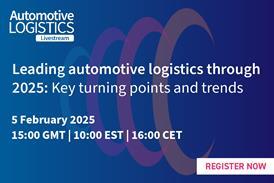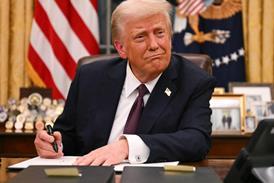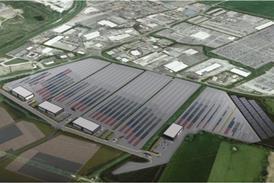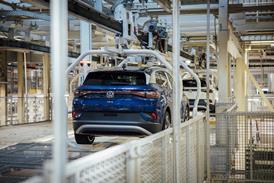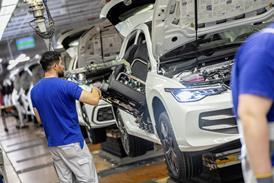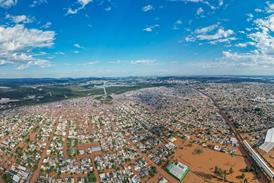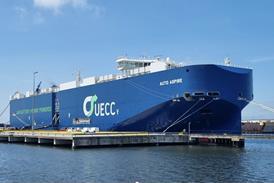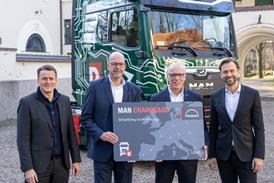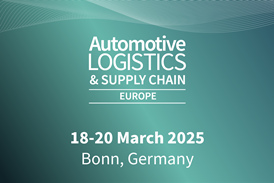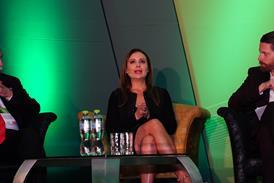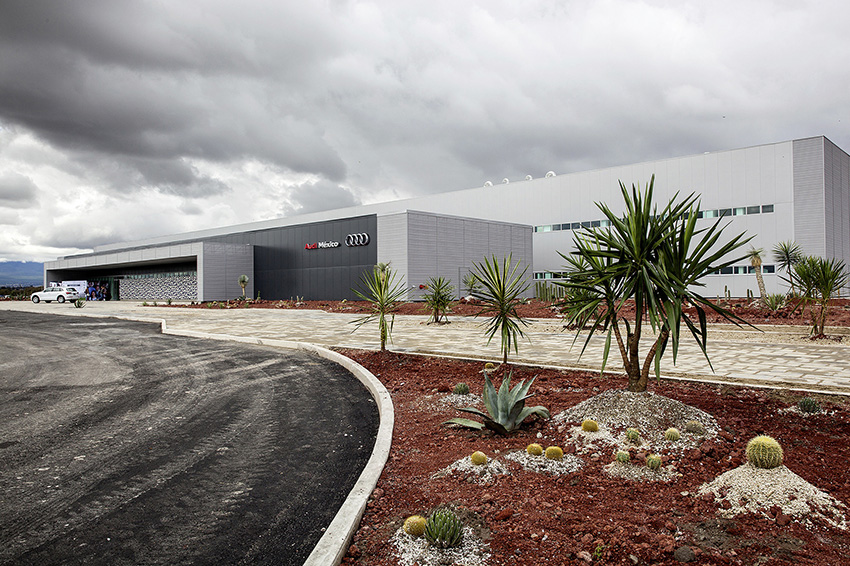Audi Mexico’s upcoming plant at San José Chiapa has had logistics efficiency built into its core. Automotive Logistics talks to head of logistics and production control, Peter Koltai, about the evolution of the OEM’s first standalone factory outside Europe
The 70km drive from Puebla to San José Chiapa takes less than an hour if you leave early enough in the morning and there have been no road incidents. The route is a well-maintained autopista, although the one-and-a-half lanes on either side – apparently common for Mexican motorways – might perplex first-time foreign visitors.
Once Audi’s production in San José Chiapa ramps up, lorries and nodrizas (car carriers) may end up blocking more of the road, but for now the drive is pleasant. As you leave Puebla, the city’s smog – not as grimy as in Mexico City, but bad enough to cause vehicle restrictions – quickly dissipates and you can see the region’s dramatic volcano peaks more clearly against a blue sky, including La Malinche to the north and Pico de Orizaba, Mexico’s highest mountain, to the south.

Closer to the plant, the state of Puebla has built a new exit ramp and connecting road to San José Chiapa, which officially put this small town of fewer than 10,000 people on the map. Even before the plant launches production, the road is covered with Audi and Volkswagen cars as managers, consultants and employees make their way to the factory gate. The plant itself emerges like a city lit up in the desert, its gleaming colours echoing in contrast to the empty hills and dry land surrounding it.
The factory and its grounds are also remarkable, especially from a logistics point of view. As this is Audi’s first standalone plant outside Europe, the OEM’s management has been very careful to bring both its premium products and production methods to Mexico, including managing a long supply chain from Europe. Its logistics and production control team, led by Peter Koltai, is among the most important for Audi Mexico.
Audi Mexico is thus a testament to planning manufacturing around efficient logistics, with almost everything in place that a logistics manager could ask for. All parts are delivered for picking and sequencing to an on-site logistics centre, before moving directly to the adjacent assembly hall that has a central supermarket where kitting carts are filled and moved easily to the line.
A supplier park stands next door, where suppliers build in sequence to Audi’s production and move a short distance to the assembly hall. Just a few hundred metres away, the carmaker is also setting up a complete knockdown kit (CKD) centre, where parts will be packed into sea containers for versions of the Q5 that will be assembled in China. Parts and components will also be shipped to India.
Local transport infrastructure is top notch and the plant has a rail yard that handles containers and vehicles. Koltai wants to move around 85% of vehicles from the plant by rail, including northbound to the US and Canada, as well as to the ports of Veracruz on the Gulf coast and Lázaro Cárdenas on the Pacific. For ocean containers, Audi wants to split transport between the port and plant evenly between road and rail.
Audi also has plenty of space. Logistics areas, for example, are not in any immediate danger of being pushed to external warehouses.
For inbound and outbound logistics, Audi has also benefitted from its partnership in planning and purchasing with Volkswagen de Mexico in Puebla, with considerable support from the Audi brand and Volkswagen group logistics in Germany.
 While the transport chain has been highly collaborative between Audi and Volkswagen, many aspects of the plant’s internal logistics are uniquely Audi, including advanced order and forecast methods, the use of pick-by-voice in the plant and an ambitious project to equip every container that moves in and out of the plant with an RFID tag – a first for the Volkswagen Group. The finished vehicle yard is also covered with hail nets to prevent damage during storms.
While the transport chain has been highly collaborative between Audi and Volkswagen, many aspects of the plant’s internal logistics are uniquely Audi, including advanced order and forecast methods, the use of pick-by-voice in the plant and an ambitious project to equip every container that moves in and out of the plant with an RFID tag – a first for the Volkswagen Group. The finished vehicle yard is also covered with hail nets to prevent damage during storms.
Much of Audi’s supply chain and logistics plan is as yet untested. Some of the halls are technically still construction sites, with logistics workers wearing hard hats and high-visibility jackets. However, Koltai makes it clear that after so much preparation and planning, Audi’s logistics team is ready to put plans into action when series output of the Q5 starts later this year.
Interview: Better togetherChristopher Ludwig (CL): How important was it to work with Volkswagen de Mexico on logistics for the new plant?
Peter Koltai: “There have been many benefits. For one, we have more market power thanks to Volkswagen’s strong position in Mexico. On its own, this plant will have capacity for 150,000 cars per year; in Puebla, Volkswagen can do approximately 600,000. That is four to one, but together we are five. That gives us different prices with hauliers and providers.
“Secondly, we have tried to bring our best concepts and processes for logistics from Europe. However, when we arrived in Mexico, it was not entirely clear how we could turn this into reality, as we cannot have the same requirements for suppliers and hauliers here. It was important to learn from Volkswagen what problems we would face and how to manage that.
“There are additional points that we will look into as we ramp up. For example, we have a collaboration with Volkswagen in Mexico and the next step is to do the same with Volkswagen’s plant in Chattanooga [Tennessee].
CL: Are the synergies mainly in purchasing, or are you also going to combine freight?
“We will combine freight. If it is the same supplier, we do the transport together. If, for example, we are picking up from different suppliers in the north of Mexico, freight is moved to a crossdock in Puebla where it is separated between Volkswagen and Audi. Of course, where we can move full truckloads, we’ll do it.”
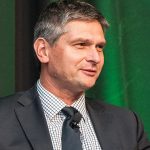 “All of the logistics controlling functions remain in Audi’s hands… We need full transparency, which is why we have set clear handover points between suppliers, Audi and logistics providers” - Peter Koltai, Audi Mexico
“All of the logistics controlling functions remain in Audi’s hands… We need full transparency, which is why we have set clear handover points between suppliers, Audi and logistics providers” - Peter Koltai, Audi Mexico
CL: Are you also sharing sea containers?
“Not the containers themselves. Most of what Volkswagen receives from Europe comes from a CKD packaging centre in Wolfsburg, whereas Audi receives most of its containers from a centre in Ingolstadt, 600km away [from Wolfsburg]. Some parts, such as engines from Hungary, are loaded directly and shipped to Mexico. However, the containers meet in the same port and move on the same ship.
“Here in Mexico, our plants have different infrastructure. While we can receive the container by train, in Puebla Volkswagen has to use lorries. We would like a dedicated train from Veracruz with containers, and to move the rest by truck. The transport is purchased together, but the physical flows are separate.”
Designed for logisticsCL: The plant here has been built with many logistics processes in mind. What makes it unique?
“First of all, our logistics operations are very close to the assembly line. Our logistics hall, where we arrange all the internal sequencing, moves directly to the assembly line. The bodyshop is also directly connected to the logistics and assembly buildings, which has fantastic benefits. In older factories, logistics is usually pushed out as the production areas expand, which adds handling steps. Here, we have a minimum amount of handling between all of our logistics and production. Our logistics hall is able to receive 53ft trailers from North America as well as 40ft containers from Asia and Europe.
“We also have a just-in-sequence (JIS) park next to the factory to give JIS suppliers the benefit of being in the same building as well. Material from suppliers is picked up with the same lorry and shunted over to one gate. We saved a lot of money [by] avoiding having many docking stations at the assembly building. Our processes also mean that we don’t need to use a forklift for JIS suppliers, as material moves straight out of the lorry directly to the point of use.”
CL: Ingolstadt has an automated warehouse for small-load carriers (KLTs). Why didn’t you replicate that here?
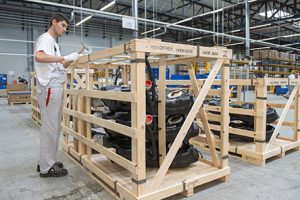 Audi will receive many parts from Europe, although it is quickly increasing localisation in Mexico
Audi will receive many parts from Europe, although it is quickly increasing localisation in Mexico“In Ingolstadt, of course, the real estate and labour costs are much higher, which are very important when you consider how to handle logistics. For that reason, we don’t need automatic storage for small KLTs in Mexico, but can do it manually. However, we have brought here all the other control systems and processes that we have learned in Europe, whether from Ingolstadt, Neckarsulm, Brussels or Gyor. We have the highest level of controlling here that you will find anywhere at Audi.”
CL: About 35% of material will come from Europe with lead times of 10-11 weeks. Since that is longer than Audi’s usual production planning horizon, how will you manage that?
“We have to divide this issue into two categories. There are parts from Europe that do not have a high complexity, perhaps just two different variants, like right or left, without colour or technical variants. You can cover parts like this with buffer storage that allows you to react with relatively low costs. If a part has many technical variants – let’s say 20 rather just two – then you cannot cover it with stock alone. If you try, you will end up with the wrong variants and have to scrap material, as well as taking up a lot of capital and space. For these parts, we are developing a more intelligent way of forecasting.
“Before we fix a production programme, we review plans together with sales and our central programme planning. We review everything in the factory, as well as our material pipeline and sales plan. Before we set a production plan, we run a simulation to test what this would look like eight weeks later, to see where we might have issues with material. This process will help us to make clear decisions, where our sales team predicts what we should build, and I’m able to see what parts we might need to fly or not. Then we agree what to do together based on those inputs. This is different to other overseas plants which receive the production programme and then decide what parts they need to fly or expedite. We are introducing an earlier step where we have input on the plan.”
CL: Since almost half of your production in Mexico will be exported to Europe, that would mean a high amount of build-to-order vehicles, especially for Germany. Will this process help you manage that?
“Yes. We will have a buffer of orders with customers and dates assigned to them. This is the pool from which we will decide our production forecast, as described. But it is very complex. The customer needs to have the car for a determined date, but what will it cost us to build it that week, especially if we have to make changes in the production flow?”
CL: Will there be longer lead times for European orders than there is currently from Ingolstadt?
“Our target is to have the same order-to-delivery time as from Ingolstadt. That will be very challenging but we want to be very close to what we offer our customers today.”
CL: How quickly do you anticipate localising more content from Europe?
“We are meeting our localisation targets. We are making fast progress.”
Tracking every boxCL: I understand you are planning to use RFID to track returnable packaging. What can you tell us about that?
“We will track our total packaging with RFID, including using our own packaging management system. In Europe, we have a returnable container pool between all Volkswagen Group factories, while here we don’t. So we will control and steer all of our packaging by RFID. We will know from every package what we have sent out to which suppliers, when it comes back to us and how long it has been at different locations. If a package is lost and it never comes back, we also know from where, and we can discuss how to replace it.
 Audi’s planned exports from Mexico – click to enlarge
Audi’s planned exports from Mexico – click to enlarge“We will also use the RFID control system for cleaning cycles for packaging, as we have automated cleaning machines for KLTs and cleaning facilities for GLTs [larger boxes]. We can set minimum requirements, such as one clean per quarter, so that when the box comes off the assembly line and into the empty goods area, the system will indicate when it needs to be washed before going back to suppliers.”
CL: Is this an Audi-developed system?
“This is the first location [where] we are applying it, but the packaging management system has been agreed with Group Logistics (Konzernlogistik) in Europe.”
CL: You will have readers in the factory, but won’t you lack visibility at all the suppliers that don’t have RFID readers?
“The first reading will be in the goods receiving area, with many readings throughout the factory as well as at the exit gate. But we already have suppliers that have come to us and asked if they can use the same technology because they will also track this packaging in their factory. This is only the start.
“The tags have the ability to do more than measure container locations; [they] can also provide information on its contents, including part numbers, quantity and suppliers. That is the next step to making this a truly intelligent packaging system. But these are future musings for now; first we have to achieve and validate the tracking process.” (For more on tracking packaging, see Packaging: Thinking smarter outside the box.)
CL: Are you using LSPs onsite for internal logistics?
“We do have strong partners in logistics, but control has to remain with us at all times.”
CL: Are you carrying out more processes in-house here, including kitting and line feeding?
“All of the logistics controlling functions remain in Audi’s hands. We use logistics providers for those processes that do not have any impact on the quality of the parts. We need full transparency, which is why we have set clear handover points between suppliers, Audi and logistics providers. For example, a logistics provider picks up parts after we have a call-off from the assembly line, but it hands control back over to Audi for delivery to the line.”
CL: Looking out to series production and beyond, what does Audi need to do to ensure logistics will be stable?
“It starts with our employees and ensuring they have the right qualifications so that they are able to maintain our series production processes according to the targeted takt time. Our suppliers need to deliver quality in the required amount that we need, and our logistics providers need to be able to deliver the parts with the right speed and time windows. It is no different than any other factory.”
CL: Are you worried about infrastructure shortfalls?
“We needed roads and we received them. We needed a railway and we got it. We don’t have a river, but we can’t get much help there! The last one is really the telecommunications network, which is more of an issue here. We hope it will improve because some of our logistics systems rely on the mobile network. Without progress here, we will have a problem. We’ve solved almost everything else – transport and electricity – but the mobile network is the last major issue.”
For more on the Volkswagen Group in Mexico, see Volkswagen & Audi in Mexico part 1: Sharing logistics in a state of expansion. For more on the Volkswagen/Audi outbound logistics operation in Mexico, see Volkswagen & Audi in Mexico part 3: Building in an extra level of efficiency.
 Although Peter Koltai didn’t have previous experience in North America, he was a natural choice to launch Audi’s important plant in San José Chiapa.
Although Peter Koltai didn’t have previous experience in North America, he was a natural choice to launch Audi’s important plant in San José Chiapa.
The native Hungarian joined Audi in 1996 after studying business administration in Germany, and was instrumental in the development of Audi’s important engine and assembly plant in Gyor, Hungary. When he joined, the plant was producing around 1,000 four-cylinder engines per day; five years later, it was producing 6,500 varying engines per day of up to ten cylinders, as well as the Audi TT. Today, the factory supplies most Audi engines globally and also builds versions of the A3.
After a stint at an Audi subsidiary in the UK, Koltai returned to Germany with responsibility for inbound production control at Audi’s plant in Ingolstadt, its largest globally. By 2007, he was responsible for internal logistics there, running one of the most complex logistics operations in the world as the plant builds 2,600 cars per day with extremely high parts variety. The plant has also built the Q5, which will be assembled in Mexico for the global market starting in the second half of 2016.
Koltai was appointed as the logistics project leader for the Mexico plant in 2013 and has been based in San José Chiapa since February 2015.


